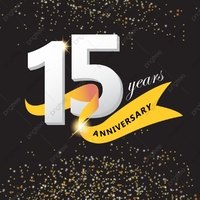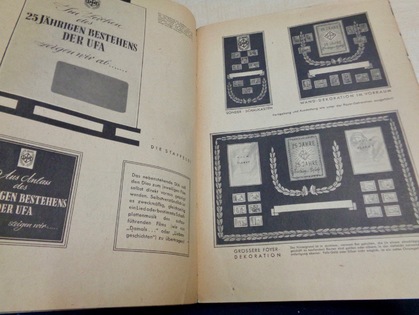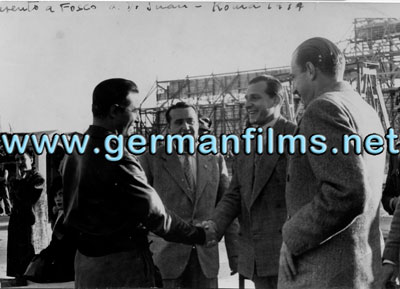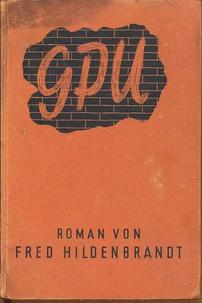What was new in 2018?
Our first acquisitions are two extremely rare Imperial Japan - circa 1938/39 - Olympia film items promoting Leni Riefenstahl's classic film in wartime Japan. The first item -- depicted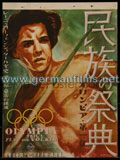 RIGHT -- is a two–sided A3 press-sheet printed on thin cardboard. One side depicts B&W stills from the film with Japanese Kanji text. The other side is an A3 colour mini-poster of the famous discus–thrower from Part I of the film. The second item --depicted LEFT -- is an actual film poster, backed on linen and in excellent
RIGHT -- is a two–sided A3 press-sheet printed on thin cardboard. One side depicts B&W stills from the film with Japanese Kanji text. The other side is an A3 colour mini-poster of the famous discus–thrower from Part I of the film. The second item --depicted LEFT -- is an actual film poster, backed on linen and in excellent 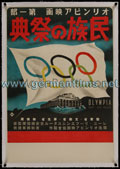 overall condition, of an Olympia film motif which is not one found in our French, Belgian, Finnish nor Czech original posters for the film. It is of the Olympic flag, with a small B&W photo montage of the Parthenon, and the title of the film in Kanji. The poster is 21 inches x 30 inches in size.
overall condition, of an Olympia film motif which is not one found in our French, Belgian, Finnish nor Czech original posters for the film. It is of the Olympic flag, with a small B&W photo montage of the Parthenon, and the title of the film in Kanji. The poster is 21 inches x 30 inches in size.
Update: These Olympia film items have now been photographed and can be found in our Poster Gallery.
----------------------------------------------------------------------------------------------------------------------------
The Uƒa film studio celebrated its 25th anniversary in 1943, marking the occasion with the extravagant and costly special effects fantasy film on 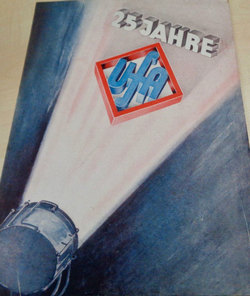 Baron Münchhausen. The Total War restrictions placed on German society suspended most film publications and full–colour advertising materials, but we have acquired a rare silver anniversary publication by Uƒa aimed at German cinema owners. This is one of the only colour Uƒa publications which we own from 1943, and are delighted to add it to our Publications Library.
Baron Münchhausen. The Total War restrictions placed on German society suspended most film publications and full–colour advertising materials, but we have acquired a rare silver anniversary publication by Uƒa aimed at German cinema owners. This is one of the only colour Uƒa publications which we own from 1943, and are delighted to add it to our Publications Library.
Up-date: We have scanned all 12 pages of this brochure and set up a new web page devoted to it here.
----------------------------------------------------------------------------------------
The 1934 film Der verlorene Sohn, starring and directed by Luis Trenker is considered an early propaganda film of the Third Reich, albeit mild in the overall ideological tendency. Partially filmed in Great Depression Manhattan, it contrasts the happy idyllic, bucolic life of Tyrolean farmers as contrasted with the grim reality of US soup lines, unemployment and despair. It is a classic and a film for which we have never been able to acquire an original German poster. We have had a large format French poster in our Collection, as well as some original German film stills. We have now purchased an original German poster, albeit without the film title or cast credits. This is undoubtedly a foreign distribution poster, printed in Germany and exported to a foreign land where an over-printing in that country's language would provide local audiences with a film title they could understand. This poster remained unused in that way. The graphic designer was Kurt Geffers, who was one of the most prolific and respected graphic artists from Weimar era through to the post-war decades. We show at left below the actual poster sheet we have acquired, and to the right the full poster as it was printed for Germans in Nazi Germany. The difference in the ink colouring of the two images is due to the one on the right being a poor quality snapshot of the poster in another collection. The colours of the image of our poster sheet at left are true to the actual colours of the poster.
Update: This poster sheet can now be found in our Poster Gallery. Further update: We have acquired 32 first–release film stills for this early Third Reich film.
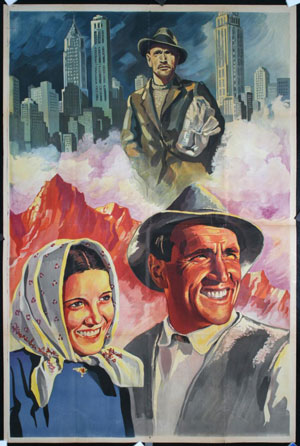

----------------------------------------
It was only a few months ago that we acquired an original 1942 poster for the important Italian WWII military film, Giarabub. The film is described in our "What was new in 2017?" web page and with the poster itself in our Poster Gallery. We have now acquired, by coincidence and luck,
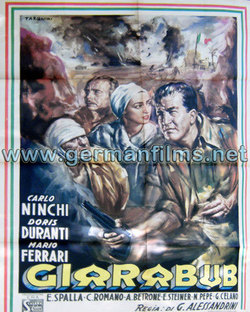 the second version of this poster by the same graphic artist. We also obtained from the seller two Fotobusta from the same film, to add to the six we already have. The second poster and the 2 new Fotobusta have been photographed and added to our Poster Gallery.
the second version of this poster by the same graphic artist. We also obtained from the seller two Fotobusta from the same film, to add to the six we already have. The second poster and the 2 new Fotobusta have been photographed and added to our Poster Gallery.
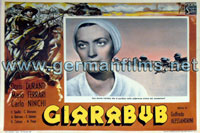

---------------------------------------------------------------------------------------------------------------------
The Edgar Neville film Carmen Fra i Rossi ("Carmen amongst the Reds") was an anti–Communist spy melodrama taking place in the battle for Madrid during the Spanish Civil War. The film was based on Neville's novel and produced at the behest of Mussolini's Italy. A Spanish version with a different leading man was co-produced at the time --- the first-ever motion picture collaboration between Spain and Italy. We have a web page devoted to the film and our original Spanish poster. The film was also dubbed in German and released there in 1942 under the title In der Roten Hölle ("In the Red Hell"). See our web page to read an English translation of the film's opening night review in Berlin! Film stills are exceedingly rare. We had been very fortunate to find five stills in 2016/2017. Now we have purchased a further three from a seller in Barcelona, and one from a German seller. The first five stills were issued by Bassoli Film in Italy, the next 3 from the Hispania Tobis distributor, and the last one from the German DIFU distributor. An obscure, forgotten, long lost and recently re–discovered film, but a fascinating one!
The three new stills from the Spanish distributor of the film:
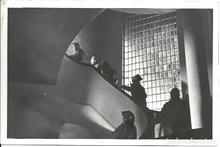
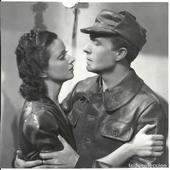
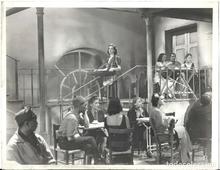
-----------------------------------------------------------------------------------------------------------------------
Any time that we can find a Filmprüfstelle censorship card for a well–known Third Reich propaganda film, we are happy to try to acquire it. We have just done so for the 1936 Karl Anton film White Slaves (Weiße Sklaven), an anti–Bolshevik melodrama with Camilla Horn, Karl John, Fritz Kampers, and Werner Hinz. We own the 1936 French poster for the film as well as the post–war re–release poster under the new film title "Battleship Sevastopol." The film was recycled and shown in the BRD during the Cold War, as were some other Nazi propaganda films (the Soviet Union using Nazi films itself --- showing Ohm Krüger in that country in the 1950s as an anti–British ploy, and the Soviet criminal puppet state the DDR showing Selpin's Titanic in those years before the film was ever shown to BRD audiences, the West Germany delay due to British objections.)
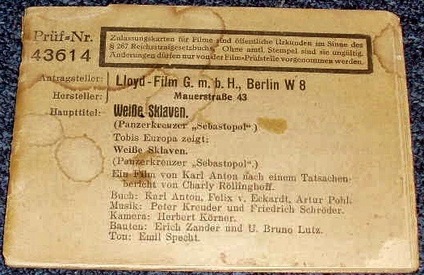
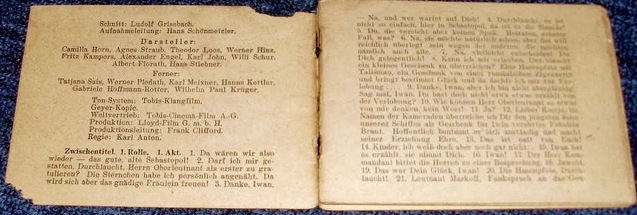
-–––––––––––––––––––––––––––––––––––––––––––––––––––––––––––––––––––––––––––
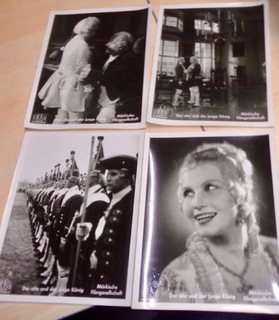 We have acquired 42 original 1935 lobby cards for the Hans Steinhoff film Der Alte und junge König, issued by Deka Film, with the Reichsadler censorship embossed imprint of the Reichsfilmprüfstelle office. It is rare to acquire so many original film stills from one single Third Reich propaganda film. The film stared Emil Jannings as Friedrich the First, tyrannical father of the young, sensitive Friedrich, known later as Friedrich der Große. The two meter tall soldiers depicted as the palace guards to the king were actual members of the Leibstandarte Adolf Hitler, from the Berlin–Lichterfelde barracks. With their uniform hats on, they towered over everyone else at about seven feet.
We have acquired 42 original 1935 lobby cards for the Hans Steinhoff film Der Alte und junge König, issued by Deka Film, with the Reichsadler censorship embossed imprint of the Reichsfilmprüfstelle office. It is rare to acquire so many original film stills from one single Third Reich propaganda film. The film stared Emil Jannings as Friedrich the First, tyrannical father of the young, sensitive Friedrich, known later as Friedrich der Große. The two meter tall soldiers depicted as the palace guards to the king were actual members of the Leibstandarte Adolf Hitler, from the Berlin–Lichterfelde barracks. With their uniform hats on, they towered over everyone else at about seven feet.
-------------------------------------------------------------------------------------------------------------------
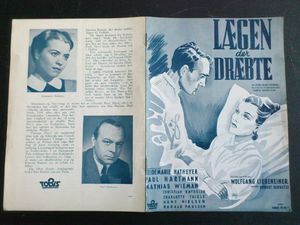
The Danish Tobis Filmkunst brochure on the Liebeneiner euthanasia film, Ich klage an, has been acquired. Note the front cover's original art work, which does not appear in the French nor German publicity for this film. It is likely the actual poster design for Denmark.
––––––––––––––––––––––––––––––––––––––––––––––––––––––––––––––––––––––––––
Our 3rd Italian MÜNCHHAUSEN poster from 1943! In this case, a 100 cm x 35 cm poster banner in bright colours. Update: This poster has now been added to our Poster Gallery.
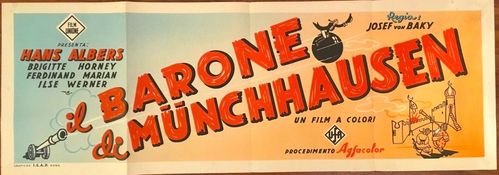
------------------------------------------------------------------------------------------------------------------
Through winning seven different auctions and through a private sale, we have acquired 51 film lobby cards and press photos for propaganda films such as Himmelhunde, Jakko, Junge Adler, Venus vor Gericht, as well as a very iconic one for Hans Westmar. All of these photographs are still en route to us, so we display below a few poor quality images from the auction sites until the real photographs can be added to our photographic collection:
(Images below fromHans Westrmar, Venus vor Gericht, GPU, Himmelhunde, respectively.)
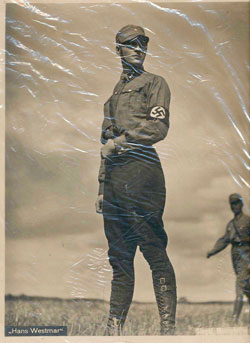
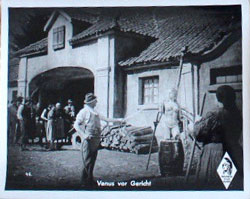

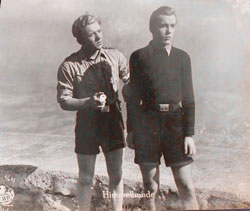
----------------------------------------------------------------------------------------
We have been able to identify the man, second from right in the photo below; who is shaking hands with Italian film star Fosco Giachetti in late 1939 at the Italian Cinecitta film studios in Rome. The photo was taken during the filming of the anti–Communist Spanish Civil War spy thriller, IN THE RED HELL.
The film's Italian title was CARMEN FRA I ROSSI and the Sanish co–production version was called FRENTE DE MADRID. The Director was acclaimed Spaniard Edgar Neville. He is shown standing directly behind the hand-shake, in the middle of the photo. And who is the man shaking hands with Giachetti? None other than Don Juan de Borbón, Pretender to the Spanish Throne, and father of the future King of Spain, Juan Carlos I.
---------------------------------------------------------------------------------------------------------------------
The German film studios had book tie–ins to their major films in the 1930's and 1940's. Not just the novel upon which a film script was based, but with 16 B&W full-page film stills from the movie scattered throughout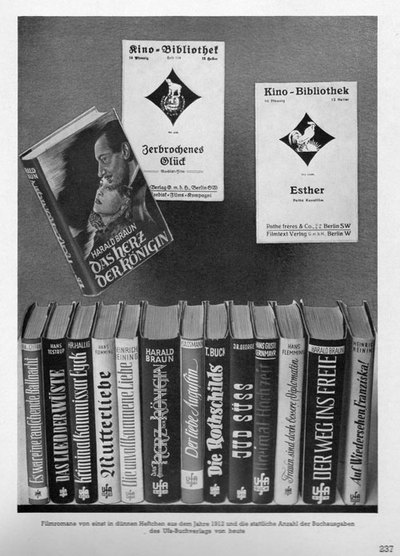 the book, as per the film's storyline plot development. We show an Ufa Book Publishing Company advertisement, at RIGHT, for such books. We own tie-in books, such as for Heimkehr, Bismarck, Germanin, Robert Koch, Jud Süß, Der alte und junge König, and we have just acquired the 1942 extremely rare book for the hard–hitting Karl Ritter anti– Soviet film, GPU. This is the only copy which we have discovered in nearly three decades.
the book, as per the film's storyline plot development. We show an Ufa Book Publishing Company advertisement, at RIGHT, for such books. We own tie-in books, such as for Heimkehr, Bismarck, Germanin, Robert Koch, Jud Süß, Der alte und junge König, and we have just acquired the 1942 extremely rare book for the hard–hitting Karl Ritter anti– Soviet film, GPU. This is the only copy which we have discovered in nearly three decades.
The book, other than the soiled cover, is in good overall condition, with all 16 B&W stills from the film in place. Another nice piece of Karl Ritter ephemera for our Collection!
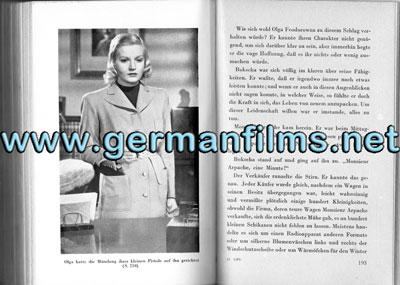
––––––––––––––––––––––––––––––––––––––––––––––––––––––––––––––––––––––––
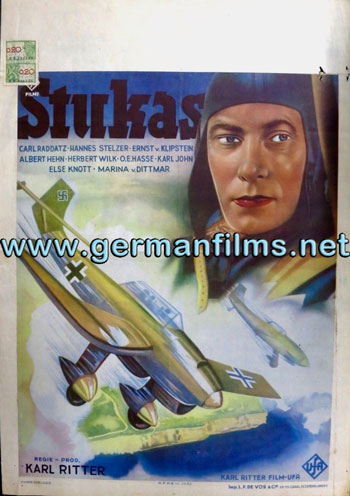
On the heels of our GPU book purchase, we have won at auction the 1941 Belgian poster for Karl Ritter's Stukas. This is a nice, clean 16 inch x 12 inch version. There is another, partial, film poster printed on the reverse side, as was common during wartime paper shortages.
–––––––––––––––––––––––––––––––––––––––––––––––––––––––––––––––––––––
Personnel ID cards issued by the Third Reich's Filmschaft e.V. and the Reichsfilmkammer do not come up for sale very often, and when they do, they are most often for unknown minor artists, or technicians, and so not terribly interesting. We have obtained the ID for a film cameraman who spent most of his career making about thirty short films, including some documentary ones; before shooting about ten feature films between 1939 and 1943; when he was drafted into the military. He died in 1964 but did not have a film career post–war. The only film of some note was his work on the 1939 feature–length documentary film, Sehnsucht nach Afrika, starring Swedish adventurer Bengt Berg and his wife. The film used footage of wild animals and jungle and savannahs in Africa taken on Berg's travels there. This African footage was then integrated into a story of six Hitler Youth boys who supposedly travel to Africa with the Bergs and have an adventure together. One of the six boys was Klaus Detlef Sierck, son of Detlef Sierck/ aka "Douglas Sirk." Young Klaus died five years later in the Soviet Union as a young soldier in the Großdeutschland Division.
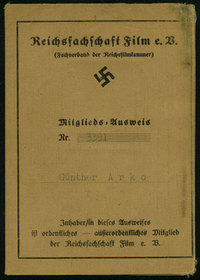
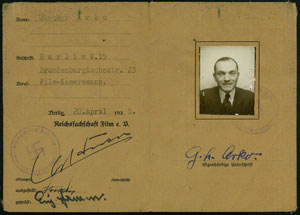
----------------------------------------------------------------------------------------------------------------------
The KDDK; or Comradeship of German Artists was founded under the auspices of Dr. Joseph Goebbels, and on October 31, 1934, opened it's Berlin offices and lavish premises, with restaurant, bar, meeting rooms, cinema and other facilities in a family villa of assassinated Weimar Minister Walter Rathenau. The KDDK club had artists and their family members from across all art forms, from film to the visual arts. Film director Karl Ritter and his wife and their oldest son, Heinz, were members. On the evening of June 15, 1939 Ritter and an entourage of Ufa film studio colleagues and Party and other dignitaries attended a recrpiton at the KDDK after the world premiere of Ritter's film Über alles in der Welt. The KDDK was also the location of the very first meeting between Ritter and high-ranking members of the Luftwaffe to discuss the efficacy of filming the script co–authored by Ritter and Fred Hildenbrandt of Besatzung Dora in mid–1942. The KDDK was also used for some of the subsequent meetings about the film. The villa was bombed late in WWII and was demolished thereafter, and KDDK items are very scarce.
The entrance to the Club, taken in 1943. A staff member is greeting "front fighters." From the KDDK's magazine in our Collection.
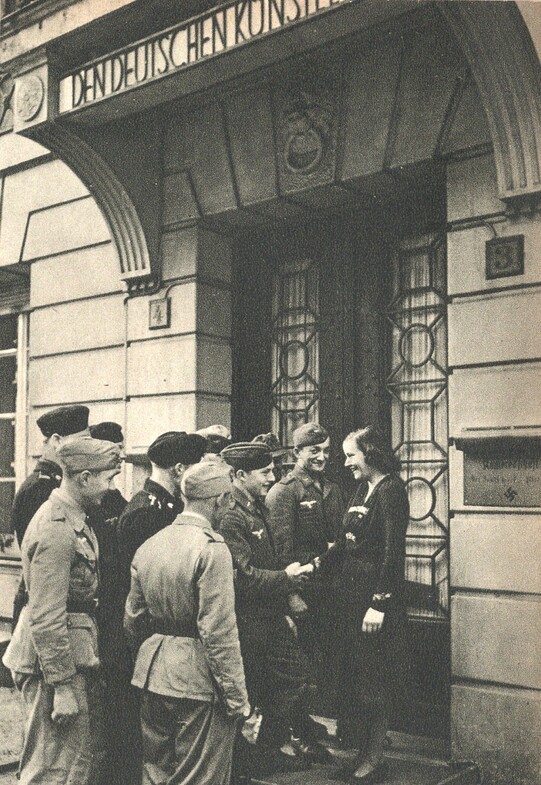
We have acquired the membership card of a member from 1938. He was a lawyer and notary.
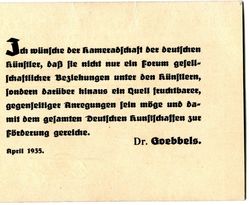
The statement by Dr. Goebbels on the reverse side translates as:
I wish that the KDDK is not only a forum for social relations, but rather may be a source of fruitful mutual suggestions, and thereby promote the whole of German art. Dr. Goebbels. April 1935
------------------------------------------------------------------------------------------------------------------------
A major Karl Ritter acquisition! In 1939, on the heels of Ritter's very successful full–length documentary film on the Spanish Civil War and the 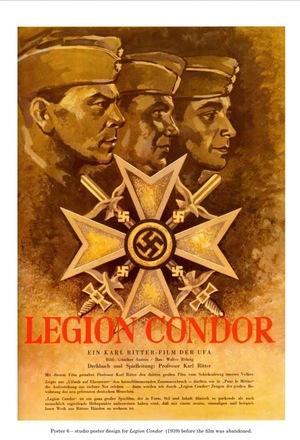 role of the Legion Condor, Im Kampf gegen die Weltfiend (In Battle against the World's Enemy #1), he and co–author Felix Lützkendorf wrote the screenplay for a feature film on that war, starring many of Ritter's top actors drawn from his previous films Stukas, Pour le Mérite, Über allies in der Welt and Kadetten, such as Paul Hartmann, Andrews Engelmann, Ernst von Klipstein, Carsta Löck, Albert Hehn, and Joseph Dahmen. The film was called Legion Condor, and was meant to be a sort of sequel to Pour le Mérite, showing those German airmen from WWI, after the re-establishment of the Luftwaffe in 1935, now going off as volunteers to fight Bolshevism in Spain. The film started shooting at the Ufa film studios in Babelsberg in early August 1939, but filming was halted after two weeks due to the signing of the von Ribbentrop–Stalin Pact; when anti–Communist films were no longer politically correct. The film was never quite completed nor shown until an 83 minute long print was presented in German and Austrian film festivals in 2016. The planned poster for the film is shown above at left, from an Ufa 1939/40 season preview catalogue in our Collection.
role of the Legion Condor, Im Kampf gegen die Weltfiend (In Battle against the World's Enemy #1), he and co–author Felix Lützkendorf wrote the screenplay for a feature film on that war, starring many of Ritter's top actors drawn from his previous films Stukas, Pour le Mérite, Über allies in der Welt and Kadetten, such as Paul Hartmann, Andrews Engelmann, Ernst von Klipstein, Carsta Löck, Albert Hehn, and Joseph Dahmen. The film was called Legion Condor, and was meant to be a sort of sequel to Pour le Mérite, showing those German airmen from WWI, after the re-establishment of the Luftwaffe in 1935, now going off as volunteers to fight Bolshevism in Spain. The film started shooting at the Ufa film studios in Babelsberg in early August 1939, but filming was halted after two weeks due to the signing of the von Ribbentrop–Stalin Pact; when anti–Communist films were no longer politically correct. The film was never quite completed nor shown until an 83 minute long print was presented in German and Austrian film festivals in 2016. The planned poster for the film is shown above at left, from an Ufa 1939/40 season preview catalogue in our Collection.
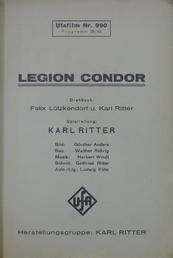
On June 29th we purchased the original Ufa film script for the film Legion Condor, with all 283 pages intact and in overall excellent condition.With this script we will be researching this film to a greater extent, with our efforts possibly resulting in a monograph to be published in good time. Given the fact that the film was not completed, and was banned due to the exigencies of the Third Reich's temporary pact with the USSR; this film script is exceedingly rare and one of the most interesting film ephemera in our Karl Ritter Collection. The Minister for Propaganda, Dr. Goebbels, reviewed the film again in March 1940, and his diary entry that day reads: Ritter's LEGION CONDOR, 2nd Part. Very well done. Unfortunately due to the strong anti–Bolshevik tendencies it cannot be used at the moment. With the attack on the Soviet Union in June, 1941, the Spanish Civil War had less relevance, so Ritter's Kadetten and his GPU were distributed as new weapons in the ideological war against "World Enemy #1."
We have now added a special page on
LEGION CONDOR to our Menu above.
-------------------------------------------------------------------------------------------------------------------------
The Hans Zerlett film, Venus vor Gericht (Venus before the Court), stars Hannes Stelzer as young proud German sculptor who is infuriated with the degeneracy of the modern art movement and the dishonesty of so–called arts experts. He sculpts a statue of Venus using a young woman from the provences as his model. He then buries it in a farmer's field and it is eventually discovered and hailed by a Jewish modern art dealer as an ancient work and then sold to the government for a huge sum. The young sculptor steps forward and declares that he made the statue and the case goes to trial. The young woman at first refuses to provide the bona fides of having posed for the statue as she fears retribution by her much older boorish husband and nasty gossip in her village. At the last moment, she relents and the case against the Jewish art dealer and the fraud is proven.
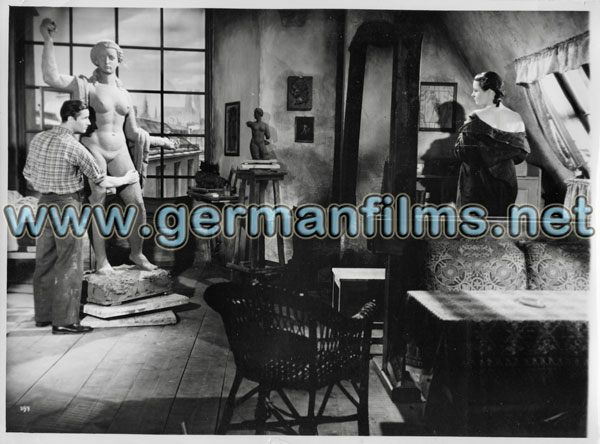
This film is still banned in Germany and Austria today on grounds of anti–Semitism and strong National Socialist propaganda. Our collection does not own a poster from the film, although we have the press–book and have had 14 lobby cards until now. Today we have acquired 34 large sized press photographs for the film, bringing our total to 48 photos.
–––––––––––––––––––––––––––––––––––––––––––––––––––––––––––––––––––––––––––––––
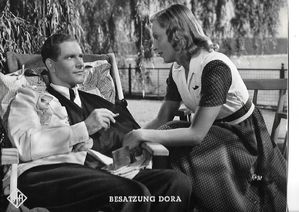 Amongst a Lot of 10 German film stills which we won, another lobby card ––albeit with the white border trimmed off –– for BESATZUNG DORA was acquiired. We continue to look for the remaining lobby cards for that film which have eluded us to date.
Amongst a Lot of 10 German film stills which we won, another lobby card ––albeit with the white border trimmed off –– for BESATZUNG DORA was acquiired. We continue to look for the remaining lobby cards for that film which have eluded us to date.
--------------------------------------------------------------------------------------------------------------
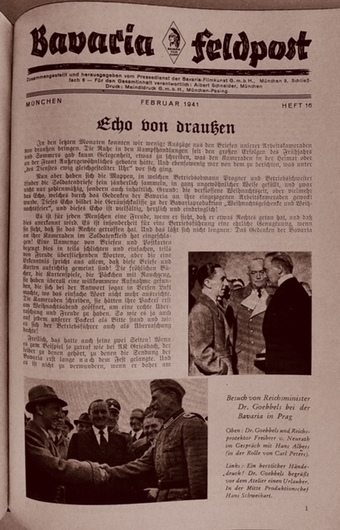
Our dozen UFA FELDPOST issues have now been joined by the first 26 monthly issues of the BAVARIA (Filmkunst) FELDPOST, dating from 7 September 1939 to the December 1941 issue.
These extremely rare newsletters were printed and posted to all Bavaria Filmkunst employees who were actively serving in the armed forces during this time: The issues are full of studio news, coverage of new film productions underway, staff news, and humourous cartoons and coverage of the studio's sports club games. FELDPOST issues were sent to the war fronts and rarely kept or saved after reading. We were fortunate to acquire a bound volume of these 26 issues, which protected them in mint condition.
-----------------------------------------------------------------------------------------------------
We have acquired a 55 inch x 77 inch original Italian 1939/40 poster for Hans Bertram‘s documentary film about the Polish Campaign, Feuertaufe (Baptism of Fire). This marks our 4th poster for this film, joining the three origianl German posters already in our Collection (including the ultra rare Gaufilmstelle poster which had a different working title, that was subsequently changed to Feuertaufe in cinema release.
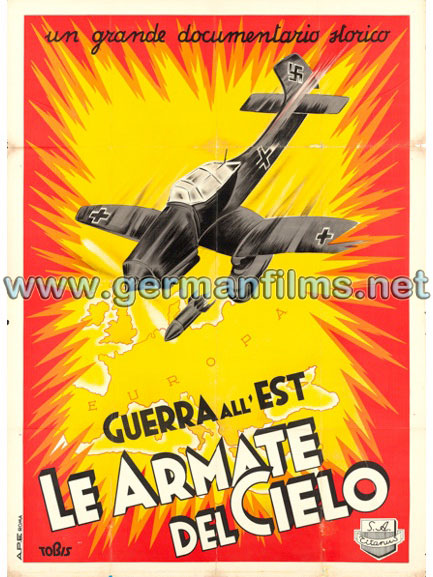
---------------------------------------------------------------------------------------------------------------------------

We have acquired another original poster for the Hans Steinhoff film, Ohm Krüger, which we have been looking for over twenty years. It is a "Kleinplakat," being 59,4 cm x 39 cm, and is one of the best graphic designs of all of the posters for this film. The poster has arrived and is now photographed and can be found in our Poster Gallery. We have seven original film posters for the film, including 3 from Germany, two from Italy, and two from France.
----------------------------------------------------------------------------------------------------------------------
Another OHM KRÜGER treasure found! When it rains, it pours. Having just won the above poster at auction, we have been offered by a Parisian poster dealer, with whom we have a long-standing relationship, this one-off original original piece of art work by French poster graphic artist René Péron for the giant “le président Kruger” poster measuring 160x240cm. The art work is 1/10th that size. Such original graphic art is called a 'maquette' in French.
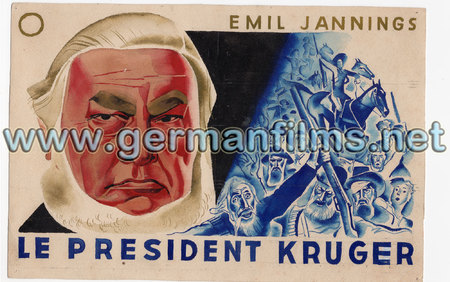
The poster that was eventually printed is shown in the upper right of the French cinema owners guide found in our German Films Collection:
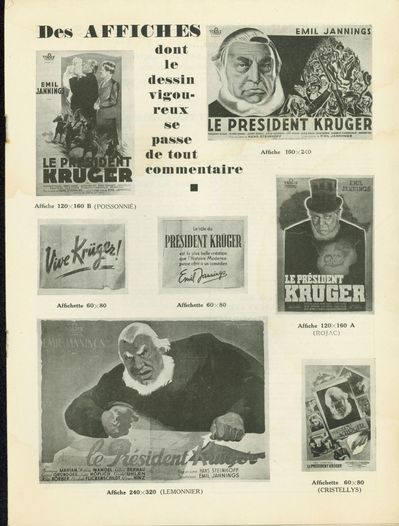
The art work, reversed to suit a two-page spread in a 1941 issue of the Occupied France film magazine LE FILM, show here, also from our Collection:
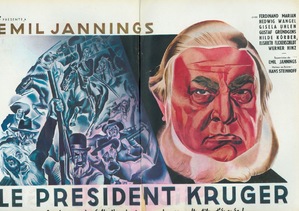
To own the original graphic art used to produce a film poster is the dream of most collectors. To own the graphic art used to produce the film poster for a motion picture such as OHM KRÜGER is something else again.
---------------------------------------------------------------------------------------------------------------------
As the the year heads to a close, we seem to have come full circle! Having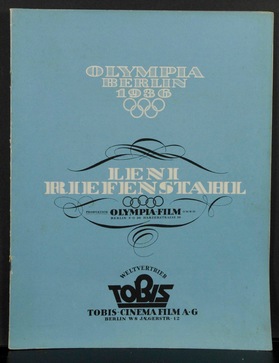 won two Olympia film posters from Imperial Japan at the start of 2018, we have now won at auction in Düsseldorf twenty-nine photographs from Leni Riefenstahl's celebrated 1938 film Olympia. There is one original press photo and 28 orginal lobby cards, as well as the Tobis Filmkunst presentation folder. Of the 28 lobby cards, we already have just five of them in our Collection, so we shall be listing these duplicates on ebay after we have received them safely from Germany. The 24 photographs (including the press photo) which are new to our archives shall bring the total Olympia number to a massive 86. This is a remarkable new acquisition by any standard.
won two Olympia film posters from Imperial Japan at the start of 2018, we have now won at auction in Düsseldorf twenty-nine photographs from Leni Riefenstahl's celebrated 1938 film Olympia. There is one original press photo and 28 orginal lobby cards, as well as the Tobis Filmkunst presentation folder. Of the 28 lobby cards, we already have just five of them in our Collection, so we shall be listing these duplicates on ebay after we have received them safely from Germany. The 24 photographs (including the press photo) which are new to our archives shall bring the total Olympia number to a massive 86. This is a remarkable new acquisition by any standard.
The five duplicates which we are currently auctioning off on ebay.com are these:
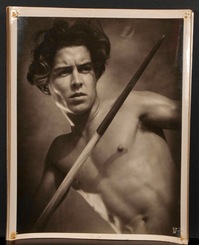
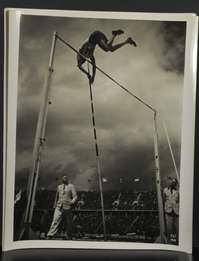


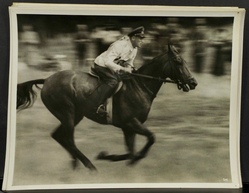
Both the Spear Thrower and the Discus Thrower portraits are two of the iconic images always associated with the motion picture, including some of our original Olympia posters. They are exceedingly rare photographs and we are fortunate to be able to offer them, as well as the other three superb classic Riefenstahl style photographs, to a serious collector.
---------------------------------------------------------------------------------------------------------------------
To close this year's page, we present an original 1941 Uƒa film studio ceramic vase, made by Rosenthal porcelain company. It was apparently made in limited quantities by the commercial division of Uƒa which made advertising and industrial films for German companies. We purchased it slightly damaged from a collector in Berlin for €5 cash, and then paid €100 to have it professionally restored by a porcelain restorer there.
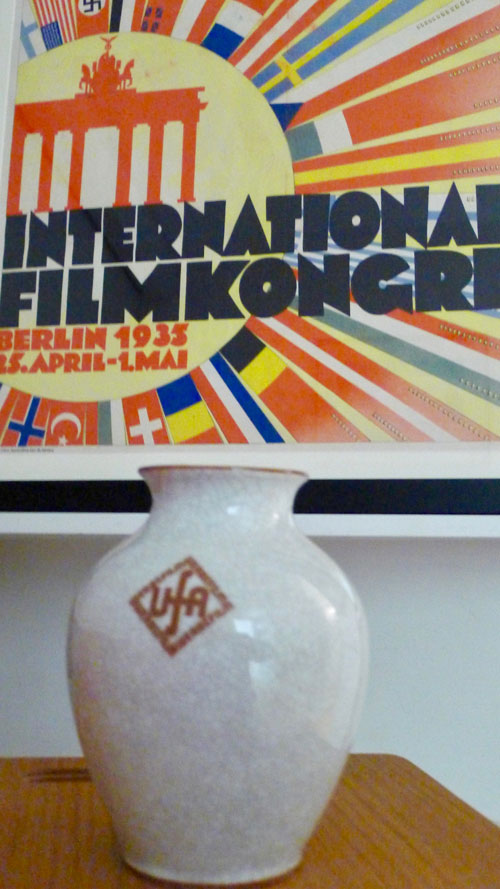
In Munich we attended the Uƒa touring exhibition from the Berlin Filmmuseum/Deutsche Kinemathek last October, and were amazed to see the same vase on display in that exhibition, along with the caption for it:
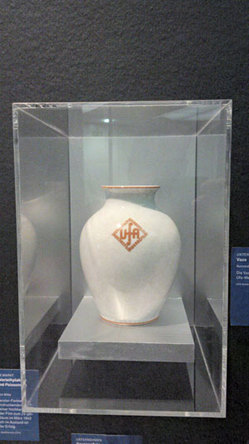
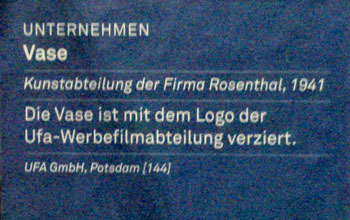
Our "What's new in 2019?" page will commence when we make our first acquisition in the new year.... Happy 2019!

